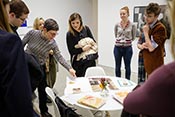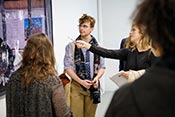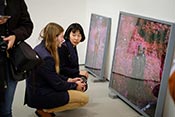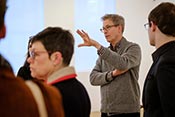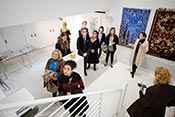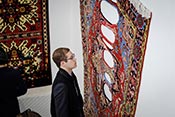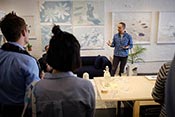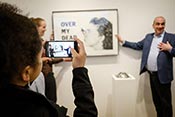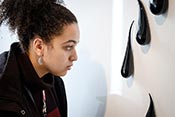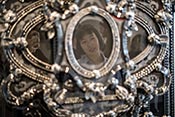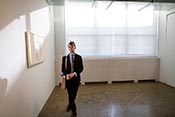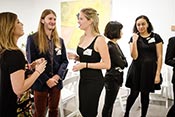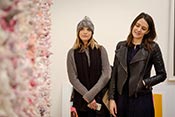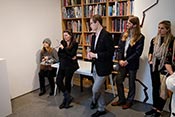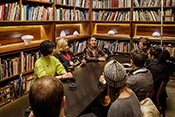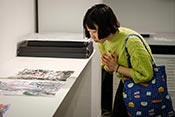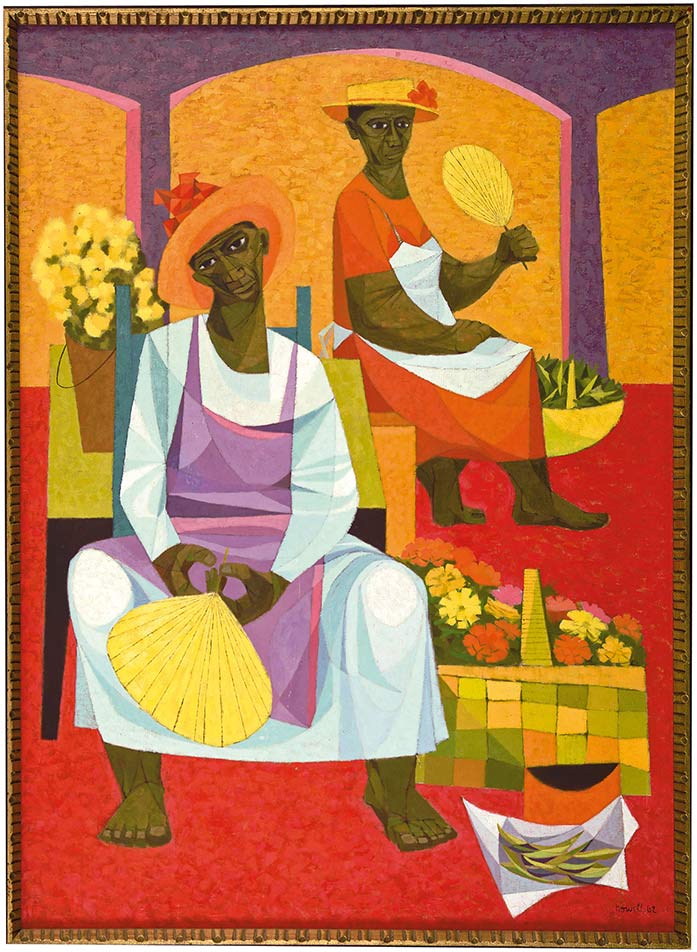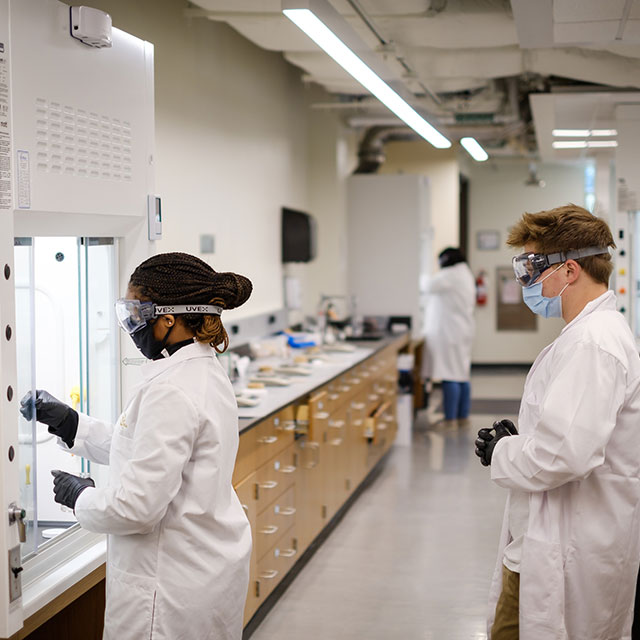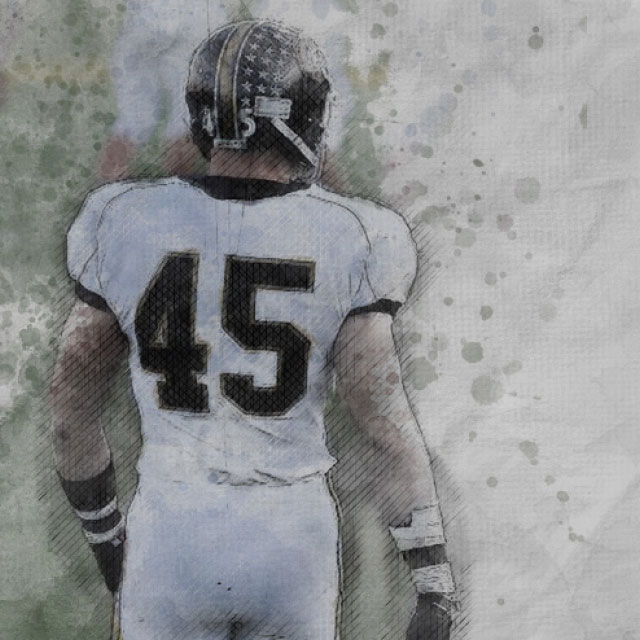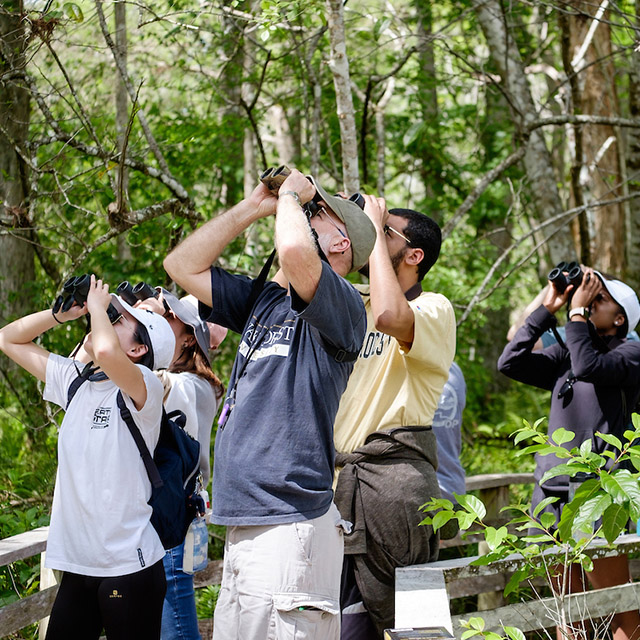Priceless
Priceless
Our timeless tradition of timely art
For some it arrives with all the subtlety of a tsunami – an unexpected but welcome slap to the senses that awakens everything right in the mind and body. For others, it can be a slow, steady build of comprehension that escalates when layers of relevance are peeled back to reveal a deeper interpretation. Fear, sadness, joy, anger, wonder, liberation, offense – the emotions are as infinite as the techniques employed to invoke them. But for those who find the lure of artistic expression irresistible, it’s a sensation worth devoting a lifetime to chasing.
Sprinkled throughout the campus of Wake Forest are more than 160 of these sensation stimuli that owe their existence to names like Jasper Johns, Pablo Picasso, Alex Katz and Louise Nevelson. They’re hiding in plain sight within hallways, study nooks and lounges – accessible to all, regardless of whether the people within viewing distance of their presence truly understand their value. All are thanks to a small fellowship of students who, for the past 54 years, has worked to bring each home to Winston-Salem.
“We’ve put hundreds of hours together into research, into meetings, into discussions. And instead of getting an A, instead of getting class credit, we’re getting something physical and tangible, something that will be here forever.” Caroline Culp (’13), member of the 2013 excursion

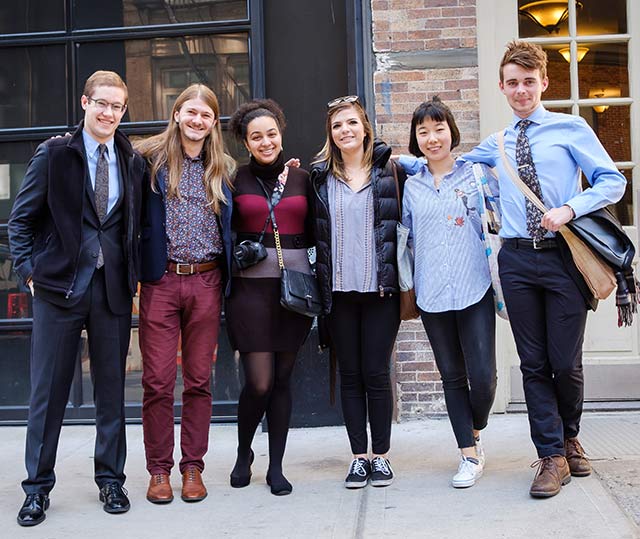
Every four years, a select group of Wake Forest students has enthusiastically accepted the mantle of curating one of the University’s best kept traditions: The Student Union Collection of Contemporary Art. As the street-tarnished snowbanks of winter cede ground to hints of spring, the students descend upon New York with the clear but titanic task of purchasing art that captures the social, political and cultural themes of the years following the previous excursion. This is the culmination of a journey that has seen its share of late nights, spirited exchange and new bonds – while rigorously field-testing the results of mixing potentially toxic quantities of business and pleasure.
“We don’t buy art by looking at pictures. If we like a work and want to consider it, we will see it in the gallery — no matter how sore our feet are at the end of the day.” Leigh Ann Hallberg, Associate Teaching Professor, faculty advisor to the 2017 excursion
THEIR 72-HOUR MOMENT
The lazy summary of this experience focuses on the fact students have $100,000 to spend on art in New York. But don’t be fooled by the myth of a six-figure shopping spree. The level of preparation that goes into this operation is nothing short of meticulous. The art acquisition team spends hundreds of hours researching artists and presenting their works to the group for consideration. Not a single credit is earned for this project, and students and faculty find time for this among the many other line items populating their schedules. The goal is to maximize both the opportunity at hand, and the budget, while keeping their collective eyes laser-focused on the prize.
So every Friday at 4 p.m., they gather around a u-shaped table with Google spreadsheets and images they found scouring the internet. They survey and discuss countless artists and possible works. Asking among the group: Will people want to look at this piece? Is it too big? Too small? Where might it hang? How does it fit with the existing collection? Do we want one expensive piece or several less expensive ones? Does this truly capture the culture of our times? In times of intense debate, a simple thumbs-up, thumbs-down vote determines the fate of the work in question.
As they narrow their choices, students begin to contact galleries to find out what works are available and the costs. They schedule appointments to visit 13 galleries during their spring break to the Big Apple. Once in New York, they log miles of walking to and from art districts, from Chelsea to Soho to Tribeca in both 60-degree weather and snow. When the gallery visits are over, it’s time to make decisions. The students discuss which works they want to purchase and complete negotiations with gallery owners on price, framing and shipping before returning to campus.
THE FINAL FIVE
When it was all said and done, five new pieces were added to the collection. While unintended, it’s worth noting all works chosen were created by international artists.
Faig Ahmed
Tap to Zoom
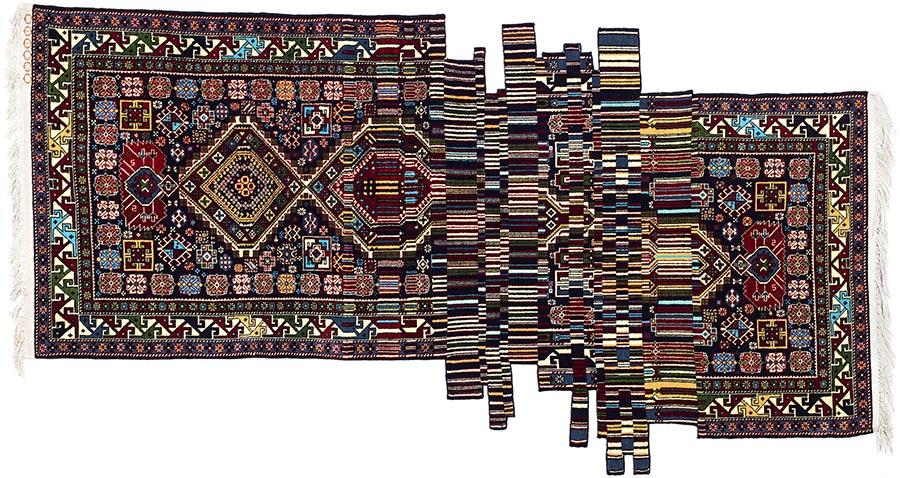
Azerbaijani
b. 1982
DNA, 2016
Handmade wool carpet
51 × 94 in
Courtesy artist and Sapar Contemporary, New York
Brooke Einbender’s
perspective [1:20]
Open Transcript
Faig Ahmed, “DNA”, presentation transcript
This is “DNA”, by Faig Ahmed. It’s a handwoven wool carpet, that is 51x94 inches. Faig is interested in traditional craft and the visual language of carpets. He uses traditional methods of carpet weaving, with a loom, natural dyes and wool, all while deconstructing these traditions by juxtaposing contemporary themes and codes. Faig works in collaboration with local weavers in a village near his studio.
These women have used the same handweaving techniques to create carpets for hundreds of years. Faig was fascinated by the origin of language and linguistics before he became interested in carpets. He sees traditional carpet designs as a coded message, similar to ones’s inherent DNA. He replicates traditional designs and then alters them, so he is reconfiguring the carpets’ DNA code. For our committee, acquiring a Faig Ahmed carpet was unanimous decision.
We are fortunate to acquire one of his carpets early on in his art career, since he is only 35 years old. We believe that DNA does much to enhance the Student Union Art Collection, as it is an interesting dialogue with Robert Motherwell’s large tapestry, and also the coded text-based works of Do Ho Suh and Glenn Ligon.
Mona Hatoum
Tap to Zoom
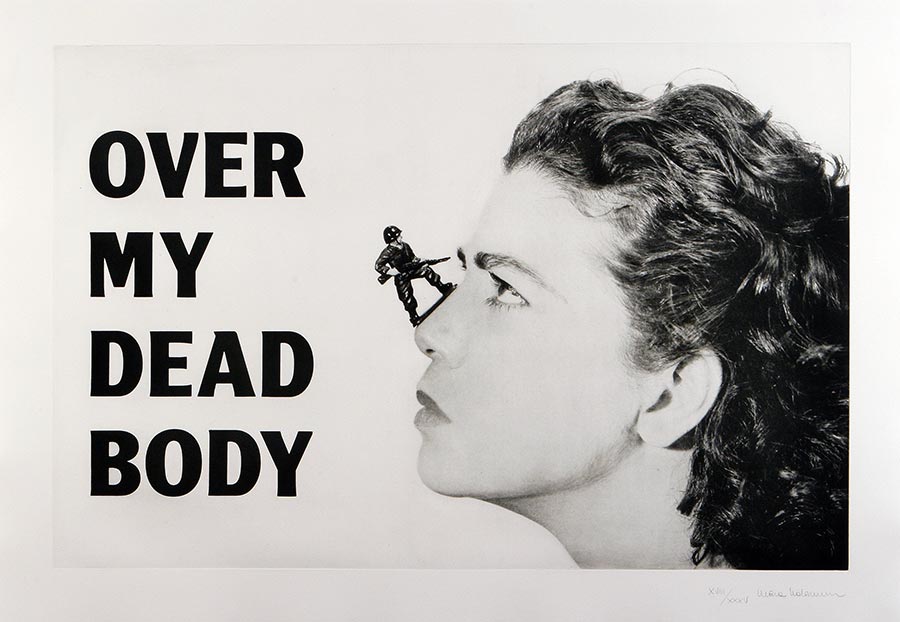
British-Palestinian
b. 1952
Over My Dead Body, 2005
Heliogravure
27 x 39.25 in
Photo: Bill Orcutt
Courtesy Alexander & Bonin, New York
Addison Wang’s
perspective [1:27]
Open Transcript
Mona Hatoum, “Over My Dead Body”, presentation transcript
The work we purchased is “Over My Dead Body” by Mona Hatoum from 2005. The reason that we chose this work is, first of all, we find it historically meaningful and also relevant in today’s world and related to warfare and gender identity and a lot of other very important contemporary issues. It is in dialogue with a lot of postmodernist works from the 80s – for example, the works by Barbara Kruger and Sidney Sherman. I think by putting this work in context with a larger or historical background, people and our students especially on this campus, will get a better idea and a more educational takeaway from this piece.
This work is also meaningful because it is a work that plays with the idea of warfare and, people’s body. In this picture, you can see that we see Mona’s face in profile and there is a toy soldier that is perched on her nose. We find this piece interesting because by this juxtaposition of different scales, that it’s the artist’s choice to make the symbol of war very small and her head very big in this picture. We think that she plays with this idea of warfare very humorously and light heartedly – that is, by understating how cruel and gruesome the warfare is. That’s the humor that we find really interesting and attractive in this piece.
Richard Mosse
Tap to Zoom
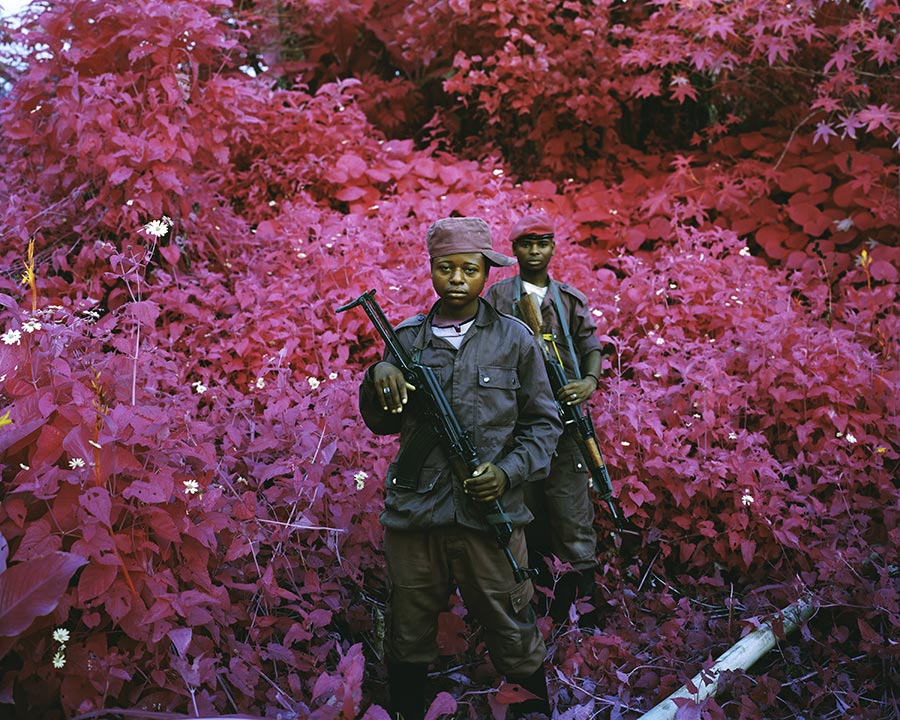
Irish
b. 1980
Man-Size, 2011
Digital C-print
40 x 50 in
© Richard Mosse. Courtesy of the artist and Jack Shainman Gallery, New York
Will Coleburn’s
perspective [1:27]
Open Transcript
Richard Mosse, “Man-Size”, presentation transcript
The work you’re seeing is “Man-Size” by Richard Mosse. It’s a part of his Infra series, which is a series that uses this military reconnaissance technology called Kodak Aerochrome. It was originally used to take aerial photos of the underbrush. What it does is it renders the chlorophyll, the light that’s reflected from plants, as this bright hot pink or red or lavender, somewhere in that spectrum. How this technology was originally used was to locate people in the underbrush to target them. For instance, camo would not render in the hot pink color; it would be green. And so you could tell the difference between the hot pink foliage and the green camouflage.
What Richard Mosse here has done is subverted the use of this technology because it’s no longer being used to target people, but to create these portraits of conflict and the people who are caught up in it, the victims. In this case, he spent the better part of four years on the ground in the Congo documenting a conflict that received very little media attention from Western outlets. Since 1998, more than 4.5 million people have died as a part of this conflict, and I think this work gives a face to some of the victims caught up in that.
Man-Size, the title, speaks directly to the two young boys that you’re seeing in the image, child soldiers forced to grow up before their time and fighting in a conflict that they probably don’t understand. I think that’s part of the nature of modern warfare, and we really liked how this gives a face to that, gives a face to victims caught up in that. We really wanted that to be a part of the collection.
Shirin Neshat
Tap to Zoom

Iranian
b. 1957
Marjan (Masses), from The Book of Kings series, 2012
Ink on LE silver gelatin print
40 x 30 in
Copyright Shirin Neshat
Courtesy the artist and Gladstone Gallery, New York and Brussels
Kayla Amador’s
perspective [1:23]
Open Transcript
Shirin Neshat, “Marjan (Masses)”, presentation transcript
This photograph is part of the Masses series of photographs, which is part of the larger Book of Kings series of photographs by Shirin Neshat. It is a group of photos of Iranian Americans living in New York. What Shirin Neshat has done is write text over their faces, notably not covering their eyes and not covering their mouth. This text is from the Book of Kings, which is a work that established the Farsi language in Iran.
Something that captivated us about this piece was the way that Marjan is looking at you, and the way that her expression is so complex. She doesn’t look particularly angry, sad – it’s a complicated look. It’s a face, an expression, that kind of explores all the contradictory feelings of an Iranian American. When we entered the gallery, and saw these works, first we were taken aback by the way that the detail is so much different in real life, than it is in a photograph.
When you step up close to one of these works, you’re really able to see the intricacies of the handwriting on the work and on the face. The way that the text smooths itself onto the face, it doesn’t look as though it’s written on top of the face; it really is embedded within the skin. I think that was something that captivated us, both emotionally, technically, artistically.
Sun Xun
Tap to Zoom
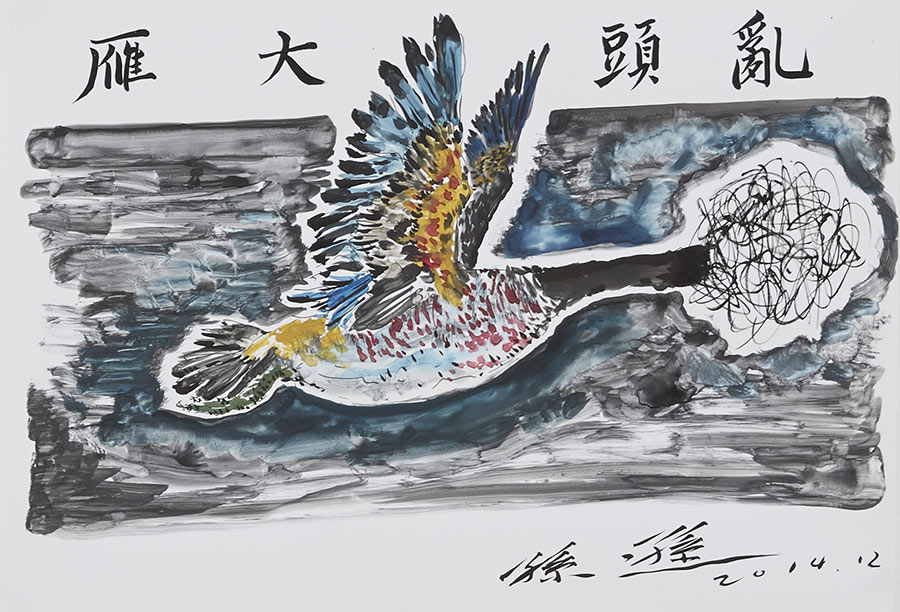
Chinese
b. 1980
The Time Vivarium – 81, 2014
Acrylic and ink on paper
13 x 19 in
© Sun Xun
Courtesy: Sean Kelly, New York
Jay Buchanan’s
perspective [1:24]
Open Transcript
Sun Xun, “The Time Vivarium – 81”, presentation transcript
Sun Xun is a fantastic Chinese animator. He works in stop-motion film and primarily uses some paint and ink as well as woodcuts in that process. We were very drawn to a number of his works from the “Time Vivarium,” which is a short film he completed a couple of years ago. The entire piece centers on cultural legacy and the way that we think about things in our society. We selected one work of Sun Xun’s when he visited Sean Kelly Gallery in New York and it is frame 81 of the film. It shows a goose flying at top speeds with its head covered by a moving cloud. In the film, you see these clouds jumbling all around the bird’s head.
In this one shot, it’s just a blind bird. We thought that that was particularly interesting as we think about today’s socio-political atmosphere. The idea of moving in a very fast pace, but not really knowing exactly where we’re going, or if we’re going in the right direction – if we’re just flying blind – is pretty significant. We were also very drawn to Sun Xun the more, as the secondary reason, for the fact that he is a representative of Chinese artists and we have a growing Chinese population at Wake Forest. We saw it as an opportunity to bring in Sun Xun’s masterful use of color and line and that sort of thing, a representative of the Chinese population at Wake Forest.
WELCOME HOME
Once the scouting, traveling, viewing, negotiating and final delivery have all been checked off, the time has finally come for the art to meet its new community – one that’s been eagerly anticipating the arrival of its newest residents. The introduction to these new pieces was formally made during Homecoming through an exhibition in the Hanes Gallery titled ex postGlobal (open to the public through October 15), echoing not only the origins of the art, but the recent era of globalization at a time when nativism is gaining momentum worldwide. The students who purchased the art presented the rationale behind how they decided on each piece, and why they felt it best represented our current window in time.
“The challenge for the art-buying teams is they don’t know what’s going to stick. History is in the process of being made.They are trying to figure out what will be important in 20 or 30 years.” Jay Curley, Associate Professor of Art

A ONE-OF-A-KIND WORK IN PROGRESS
The Student Union Collection of Contemporary Art would not exist without the passion, hard work and vision of a small but dedicated fraternity of Wake Foresters that spans generations. Below you’ll find just a few of the more than 160 works that make up Wake Forest’s premier collection. Enjoy.
Swipe to View Collection
THE MUSE IN THE HALLWAY
One example of how this collection inspires thought and perspective within the Wake Forest community.

Every time the elevator opened, there it was. And eventually, the background became forethought.
During Kayla Amador’s freshman year, Glenn Ligon’s “Untitled: Four Etchings” (1992, Copyright retained by artist or artist’s representative.) adorned the wall just across from the elevator on the third floor of Wake Forest’s Benson University Center. “When I had time, I would take time to admire these prints and consider their implications,” said Amador. “This work remained in the forefront of my consciousness when I had been working on a film project for my video art class. As the assignment was to discuss an issue we felt a personal connection to, I started thinking about myself, my identity and that Ligon work in particular. I felt that this work expressed some of the experiences of people of color in a way that was on the surface, a very clear and direct message – but this was understood only if you were willing to take the time to interact with the work.”
“Something that I feel is truly remarkable about this work by Ligon is the second two of the four prints. Even when you get very close, you can barely read the quote from the ‘The Invisible Man.’ This made me think about how others may look (or not look) at communities they don’t understand, and how sometimes we might not understand ourselves, or be understood by our own communities.”
“I reached out to and interviewed fellow multiracial students on campus, and created a two-channel film in which the students recounted their own experiences with their multiracial identity – positive, negative, and otherwise. Perhaps, at times, the experience can be best described by black text on a white background, or as the work asserts, ‘feeling most colored when I am thrown against a sharp white background.’ Considering this concept, I asked the students I interviewed in my film to write on a whiteboard with black marker, words that people used when questioning their identity. In the latter half of the film, the students erase the nicknames, questions and insults they had previously written.”
Kayla’s film “Spectrum: Faces of Multiracial Identity” was purchased by Wake Forest University. The Glenn Ligon work that inspired Kayla’s film was purchased by students for the University during a student art-buying trip in 1993.

